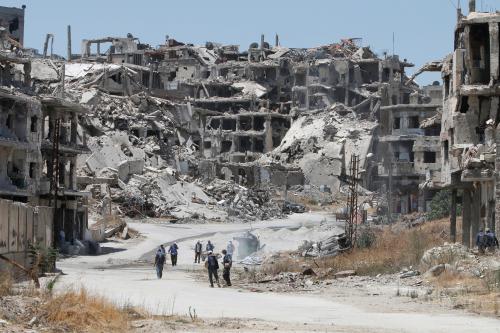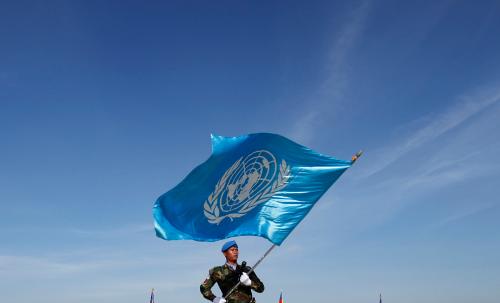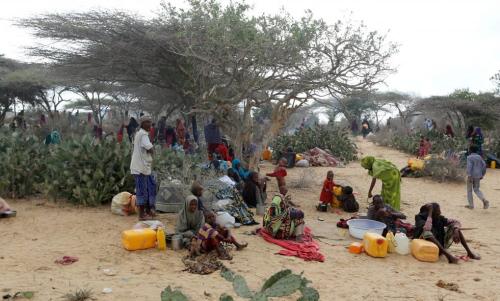The rise in fragility in countries especially vulnerable to violence, poverty, and disasters has reached immense proportions—shown by the collapse of governance and civil war in the Middle East; the historic number of refugees and displaced persons; and evidence that one out of three development dollars is lost through conflict. What’s more, it’s now clear that global poverty will not be eliminated nor the lofty Sustainable Development Goals achieved as long as states are plagued with dysfunctional governance and civil strife.
Organizations around the world are seeking solutions, but many current proposals are flawed by their lack of engagement at the political level, over complexity, and over impatience to see results.
In looking for a better path forward, three key lessons can be gleaned from past efforts to help countries that are just starting to move beyond conflict and dysfunctional governance.
My colleagues and I recently assessed the New Deal for Fragile States, through which countries committed to pursuing more political ways of addressing the root causes of conflict and fragility and to channel investments into fragile states. We found the main reason that the New Deal is limping along is because of inadequate engagement at a senior political level both in the pilot states and among donor countries, along with a failure to bring civil society into the process.
This issue has also been raised by the Fragility Study Group in a recently released road map on how to approach fragility, title U.S. Leadership and the Challenge of State Fragility.
The New Deal also shows the downfalls of being overly complex. The framework involves three baskets of commitments and goals, with the FOCUS basket requiring constructing and reaching agreement on five separate complicated components. Think about how hard it is in the United States, a supposedly advanced country with functional processes, to reach agreement on an annual federal budget, on rebuilding our infrastructure, on modernizing our education system, or on establish a rational health care system. The New Deal is a beautifully crafted structure of all the component parts of a stable society, but let’s realize what we are asking of countries with barely functioning governance and civil discourse—reaching agreement on a complex set of actions that make the issues we in the U.S. is unable to resolve look easy.
A third lessons is that the international community rushes in massive amounts of assistance at a time when the institutions of the country are barely functioning and have little absorptive capacity. After three to five years of minimal progress, we get frustrated by the corruption and failure of assistance to produce strong results and our attention and support are redirected to the newest crisis, sometimes just at the point when the county systems are beginning to function and could actually use large amounts of assistance.
Two additional lessons are worth mentioning as well: (1) Sustainability can happen only through local ownership, a concept that goes back to the Marshall Plan and has become the accepted norm since articulated in the Paris Declaration on Aid Effectiveness in 2005; and (2) that transparency, as evidenced by the impact of posting the budget on the school wall, is a critical tool for facilitating citizen awareness and government accountability.
From these lessons, we can build a simpler, more patient approach to state fragility:
- Establish a sizeable stability fund for three to five countries that have the potential to move beyond fragility or are threatened with regressing into fragility.
- One or more donors, in collaboration with the World Bank or a regional bank, finance the fund—$1-5 billon depending on the size of the country, available for 10-20 years and to be periodically replenished when 50 percent is drawn down; but which will end if sufficient progress is not made over a period of three to five years that allows use of at least 50 percent of the fund.
- A small secretariat comprised of staff from the donors and partner country, led by a person with international experience and prominence.
- Agreement by donors to accept a common format for reporting, monitoring, and evaluation by the secretariat.
- The initial focus will be on a few steps to bring the country together around a common agenda; as progress is made a few additional steps are identified that fit the context of the country, rather than a preconceived complicated plan being imposed at the outset.
- The fund and steps will be well publicized in the country so citizens know that a large pot of money is available if political and civic leaders come together to implement a common agenda.
- The chief executive officer will make disbursements from the fund along agreed-upon criteria, which will be publicly transparent and overseen by an advisory body comprised of national and international persons.
There are several elements of this approach that need to be carefully constructed if it is to succeed.
First, we need a fragility methodology to identify specific risks and the interventions that would mitigate them. Fifty countries appear on the World Bank/Fund for Peace list of fragile states. Some are clearly fragile, others, depending on one’s analysis, may be running the risk or not. The term fragility is used to indicate many different circumstances and lacks any common definition. It is used to characterize a country with a totally dysfunctional government, a country rent by civil war, or a country that might regress into instability. Fragility runs along a continuum and arises from a range of sources—dysfunctional politics, civil conflict, danger of disaster from climate change, and threat of economic catastrophe. We must be able to identify different types of fragility.
Second, a prime quandary is how to respect and promote local ownership—how to structure decisionmaking around the fund in a way that is objective and builds national institutions. This involves the ever-present dilemma of effective implementation, delivering services badly needed by citizens, and achieving visible results versus building local capacity and institutions and the credibility and accountability of national and local governance.
Fragility is a prime example of the need to deploy all components of smart powers. The diplomats and political leaders play the central role in crafting a political settle that begins to lead a state out of conflict and fragility and then working to sustain it. The military can be an important partner in that process and in helping to build security in the country. Humanitarians provide relief to those displaced and faced with scarcity of food, housing, and medicine and help them in resettlement. Developmentalists, working with diplomats at the political level, help rebuild the political, economic, and social institutions of society. Each component is essential to restoring a country to stability, and they must work together in an interlocking web.
Avoiding state risk may look expensive—in the billions of dollars—but when expended over time and in comparison to what the international community has spent in Iraq and Afghanistan—the savings in lives, destruction, suffering, and money is modest. And often the solution is much simpler, but also requires more patience, than many of imagine.







Commentary
A simpler, more patient approach to easing state fragility
November 3, 2016